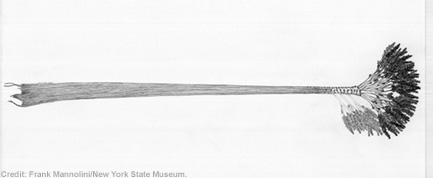
Earth's oldest known tree stood nearly 30 feet tall and looked like a modern palm, a new reconstruction shows.
Workers uncovered hundreds of upright stumps of the 385 million-year-old tree more than a century ago, after a flash flood in Gilboa, New York uncovered them, but little else was known about the tree’s appearance.
Then, in 2004, scientists unearthed a 400-pound fossilized top—or crown—of the same genus a few miles away. The following summer, the same team discovered fragments of a 28-foot trunk. Piecing together stump, trunk and crown now reveals what the full tree looked like for the first time.
“These were very big trees,” said study team member William Stein, a paleobotanist at the State University of New York at Binghamton.
“Our reconstruction shows them to be a lot longer and much more treelike than any of the reconstructions before,” Stein told LiveScience. “I don’t think any of us dared think of them being quite that big.”
The tree belonged to a group of early fern-like plants called Wattieza. Unlike flowering plants, which use seeds to reproduce, Wattieza used spores, the reproductive method of choice for algae, ferns and fungi.
The finding, detailed in the March 19 issue of the journal Nature, will help scientists understand a crucial turning-point in our planet’s history—when the first forests appeared.
Sign up for the Live Science daily newsletter now
Get the world’s most fascinating discoveries delivered straight to your inbox.
“In forming the first forests, they must have really changed the Earth system as a whole, creating new types of micro-environments for smaller plants and insects, storing large amounts of carbon and binding the soil together,” said study leader Christopher Berry of Cardiff University in Wales.
Now extinct, Wattieza lived during the Middle Devonian period, before aquatic creatures clambered onto land. “The trees preceded dinosaurs by 140 million years,” said study team member Ed Landing of the New York State Museum. “There was nothing flying, no reptiles and no amphibians.”
The rise of land plants such as Wattieza drastically altered the climate and paved the way for terrestrial animals and insects. “The rise of forests removed a lot of carbon dioxide from the atmosphere,” Berry explained. “This caused temperatures to drop and the planet became very similar to its present-day conditions.”









